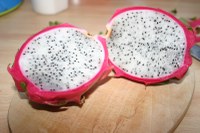Prairie Fare: Try an Unusual Fruit This Season
(Click an image below to view a high-resolution image that can be downloaded)
By Julie Garden-Robinson, Food and Nutrition Specialist
NDSU Extension Service
“What is that thing?” my husband asked as he pointed at something in the produce aisle.
“I have no idea,” I said as I walked slowly toward the bin of fruits. I reached out timidly to examine the bright pink globular thing with green spines protruding from the sides and top. I was ready to pull my hand back quickly in case this thing had teeth and claws.
“It looks weird. It must be good for you,” he noted.
“Yes, a weird appearance is always the test of good nutrition,” I said with a grin and glance in his direction.
“It’s a dragon fruit imported from Vietnam,” my husband announced as he read the sign. Frankly, this thing looked like it might have been imported from outer space.
I could tell my husband wanted me to put it in the cart. I still was trying to figure out if it was edible. I put it in a plastic bag and added it to our cart next to a couple of pomegranates.
When we arrived at the checkout stand, the checker looked at the curiosity we pulled out of our cart.
“What is that?” he asked.
We told him and he began trying to find “dragon fruit” in the computer.
“It’s also called a pitaya,” my husband said as he looked up from doing research on his phone. Our checker couldn’t find that word in his database, either.
Our checker asked for help from a neighboring checker. She opened her reference book of produce and could not find anything that resembled our “fuchsia-colored spiny wonder fruit.” It looked a little like tie-died artichoke.
By now, we were holding up a line of people with heaping grocery carts. Yes, we were “those people.” I wanted to slip on a floppy hat and dark glasses and hide behind a post, if I could find one. My husband was mouthing, “We’re sorry!” to the people in line.
The checker finally decided on a random price based on weight. I think he wanted us out of his line with our strange food selections.
For dinner that night, I rinsed the dragon fruit in cool water, put it on a cutting board and got out a sharp knife. I was ready to fillet this thing. When I cut the dragon fruit open, I exclaimed to our daughters, “Look at this!” No, it didn’t have bones.
It had a white interior with an abundance of tiny black seeds. This was inexpensive entertainment.
The flavor was very bland and reminded me of kiwifruit or a melon. I learned that a pitaya is high in antioxidants and vitamin C, and the seeds provide omega-3 fats. I’d buy it again.
Be a little adventuresome with the food you buy. At this time of the year, pomegranates also are available. They are about baseball- to softball-sized and pinkish red.
I was just as surprised to crack open a pomegranate the first time as I was to open a dragon fruit. Pomegranates are juicy fruits filled with seeds surrounded by red or pinkish covers called arils. The seeds are nestled in a honeycomblike membrane that you do not eat.
Pomegranate seeds resemble small jewels, and they make tasty additions to salads or desserts. At 72 calories per half cup, pomegranate seeds provide potassium, vitamin C, folate and other vitamins and minerals.
Pomegranates have been cultivated for thousands of years in the Mediterranean region of the world and were brought to the Americas by Spanish missionaries. Pomegranates were valued as a portable source of fluid for early explorers. They are available in the late fall and early winter, just in time for the holiday season. California, Arizona and parts of Texas are among the states that can grow pomegranates.
The next time you see an unusual fruit or vegetable at the store, give one a try. You might be pleasantly surprised. Here’s some information from Oklahoma Extension about how to seed a pomegranate. Be aware that the abundant juice from pomegranates can stain your clothing. Wear a dark-colored apron and not a white shirt.
- Cut the crown (protruding blossom end) off the pomegranate, removing with it some of the pale-yellow pith. Take care not to pierce the seeds within.
- Lightly cut through the skin from stem to crown end to divide the fruit in fourths.
- Immerse the scored fruit in a large bowl of cool water and soak for five minutes.
- Holding the fruit under water, break sections apart with your fingers, separating the seeds from the membrane. The seeds will sink to the bottom of the bowl.
- Discard skin and membranes. Drain the seeds and dry on paper towels.
This green and red salsa recipe may earn you the “most novel recipe” award at a holiday party this season. It is adapted from Simply Recipes (http://www.simplyrecipes.com/recipes/kiwi_salsa/).
Pomegranate and Kiwi Salsa
3 ripe kiwifruit, peeled and chopped
1/4 c. pomegranate seeds
1/2 avocado, peeled and chopped
1 Tbsp. green onion, thinly sliced
1 to 3 tsp. fresh jalapeno, chopped (to taste)
1 Tbsp. fresh cilantro, finely chopped
1 tsp. olive oil (or other salad oil)
Salt and pepper (if desired)
Rinse, then prepare ingredients as noted. Place the ingredients (except peppers) and oil in a bowl and toss. Gently fold in 1 teaspoon of chopped pepper to your desired level of heat. Add salt and pepper if desired. Serve with tortilla chips.
Makes six servings. Without added salt, each serving has 60 calories, 3.5 grams (g) fat, less than 1 g protein, 8 g carbohydrate, 2 g fiber and 0 milligrams sodium.
(Julie Garden-Robinson, Ph.D., R.D., L.R.D., is a North Dakota State University Extension Service food and nutrition specialist and professor in the Department of Health, Nutrition and Exercise Sciences.)
NDSU Agriculture Communication - Nov. 23, 2016
| Source: | Julie Garden-Robinson, 701-231-7187, julie.garden-robinson@ndsu.edu |
|---|---|
| Editor: | Ellen Crawford, 701-231-5391, ellen.crawford@ndsu.edu |



